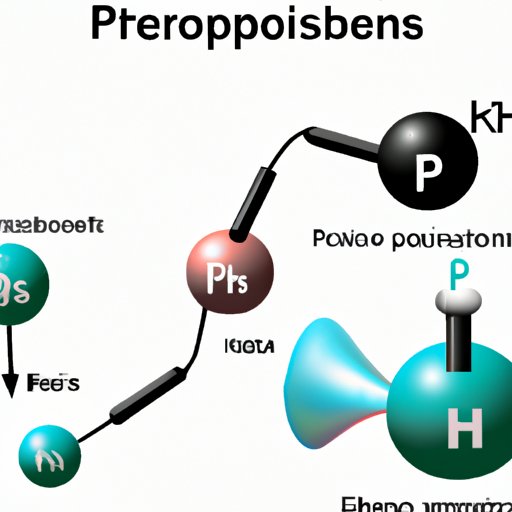I. Introduction
Phosphorus is an essential element in many biological and industrial processes, making it important to understand its atomic structure. In this article, we will explore the number of electrons that phosphorus has and its significance in determining the element’s chemical and physical properties.
II. Decoding the Atomic Structure of Phosphorus: The Number of Electrons it Possesses Explained
The atomic number of phosphorus is 15, denoting the number of protons in its nucleus. The electron configuration of phosphorus is [Ne]3s23p3, indicating that it has five valence electrons in its outermost energy level.
Electrons are arranged in shells or energy levels around the nucleus. The innermost energy level nearest the nucleus can hold up to two electrons, the second energy level can hold up to eight electrons, and the third energy level and beyond can hold up to 18 electrons. The energy levels are filled from the innermost to the outermost, with electrons occupying the most stable energy state available based on the aufbau principle.
In the case of phosphorus, there are two electrons in the first energy level, eight electrons in the second energy level, and five electrons in the third and outermost energy level.
III. The Role of Electrons in the Chemistry of Phosphorus: A Comprehensive Guide
Electrons play a crucial role in determining the chemical properties of atoms and their interactions with other atoms and molecules. Phosphorus’s five valence electrons can interact with other elements to form chemical compounds. Depending on the nature of these interactions, the resulting compounds can have vastly different properties and reactivities.
For example, when phosphorus combines with oxygen to form phosphorus oxide (P4O10), it results in a highly reactive compound that can combine with water to form phosphoric acid. Similarly, when phosphorus combines with hydrogen to form phosphine (PH3), it results in a toxic and flammable gas.
The number and arrangement of electrons in phosphorus also determine its reactivity and properties. For instance, phosphorus’s reactivity increases as it loses electrons, making it useful in reducing agents in chemical reactions. Its electron configuration also makes it a versatile element in the construction of organic compounds and pharmaceuticals.
IV. Exploring the Electronic Configuration of Phosphorus and its Importance in Biological Processes
Phosphorus also plays a crucial role in biological systems, with its electron configuration linked to its role in cellular processes. Phosphorus is a vital component of many biological molecules such as DNA, RNA, and ATP, which carry out critical functions in the body. For instance, ATP is responsible for supplying energy to the body by undergoing hydrolysis to form ADP (adenosine diphosphate), releasing energy that can power cellular processes.
Changes in the electron configuration of phosphorus can have profound biological impacts. For instance, mutations in the genes responsible for ATP synthesis can lead to mitochondrial diseases, which can result in a range of symptoms from muscle weakness to developmental disorders.
V. Phosphorus and its Electrons: An Overview of its Physical and Chemical Properties
Phosphorus’s physical and chemical properties are determined in part by its electron configuration. In its solid state, phosphorus exists in different allotropes with varying chemical and physical properties. For instance, white phosphorus is highly reactive and flammable, while red phosphorus is stable and less reactive.
The properties of phosphorus also depend on the environmental conditions it is exposed to, such as temperature and pressure. At low pressures, phosphorus exists as a gas, and its chemical properties are comparable to that of nitrogen. As the pressure increases, it transitions to a liquid and eventually a solid, with its properties becoming progressively more metallic.
VI. Unravelling the Mystery of How Many Electrons Phosphorus has: A Deep Dive into the Element’s Atomic Structure
Understanding the number of electrons that phosphorus has is crucial in determining its chemical and physical properties. In addition to its five valence electrons, phosphorus also has ten core electrons located in the first and second energy levels. These electrons do not participate in chemical bonding and largely determine the size of phosphorus’s atomic radius.
The number of electrons in the outermost energy level, commonly referred to as the valence shell, is also significant in determining the element’s reactivity. Phosphorus’s five valence electrons put it in the category of elements called the pnictogens, which tend to form covalent bonds with other elements.
The number of valence electrons can be determined experimentally through various methods, such as X-ray crystallography and electron paramagnetic resonance spectroscopy. These techniques provide insight into the element’s electronic structure and help scientists better understand its properties and reactivity.
VII. The Many Faces of Phosphorus and its Electrons: Examining the Element’s Chemical and Electrical Properties
Phosphorus’s electron configuration is responsible for many of its unique chemical and electrical properties. For instance, phosphorus is a highly reactive element that can combine with many other elements to form various compounds. This reactivity makes it useful in a wide range of industrial and commercial applications, such as the manufacture of fertilizers, flame retardants, and semiconductors.
Phosphorus’s electron configuration also makes it an important element in electronics. As a semiconducting material, it can be used to make transistors and other electronic devices. Additionally, because phosphorus has a high electronegativity, it can create electrical potential differences that are important in many biological and physiological processes.
VIII. Conclusion
In this article, we have explored the number of electrons that phosphorus possesses and its significance in determining the element’s chemical and physical properties. Understanding phosphorus’s electron configuration is crucial for understanding its role in biological processes and for discovering new applications in various industries.
Basic scientific knowledge is crucial in enabling us to comprehend the world around us and develop new technologies for a better future.
